初中英语语法重难点总结
- 格式:docx
- 大小:43.64 KB
- 文档页数:25
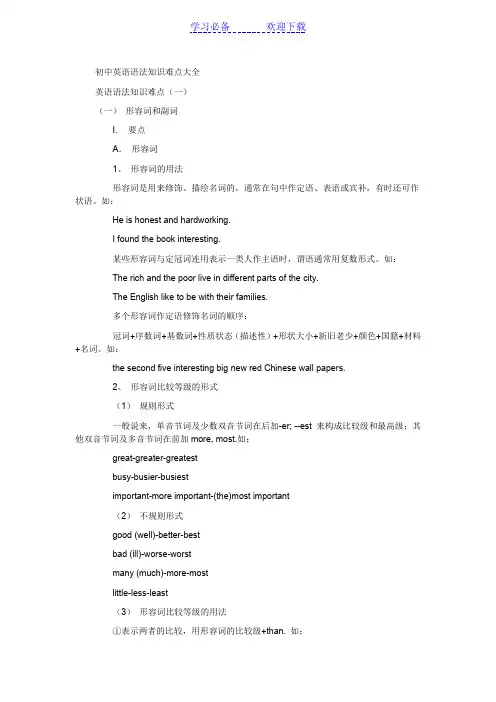
初中英语语法知识难点大全英语语法知识难点(一)(一)形容词和副词I.要点A.形容词1、形容词的用法形容词是用来修饰、描绘名词的,通常在句中作定语、表语或宾补,有时还可作状语。
如:He is honest and hardworking.I found the book interesting.某些形容词与定冠词连用表示一类人作主语时,谓语通常用复数形式。
如:The rich and the poor live in different parts of the city.The English like to be with their families.多个形容词作定语修饰名词的顺序:冠词+序数词+基数词+性质状态(描述性)+形状大小+新旧老少+颜色+国籍+材料+名词。
如:the second five interesting big new red Chinese wall papers.2、形容词比较等级的形式(1)规则形式一般说来,单音节词及少数双音节词在后加-er; --est 来构成比较级和最高级;其他双音节词及多音节词在前加more, most.如:great-greater-greatestbusy-busier-busiestimportant-more important-(the)most important(2)不规则形式good (well)-better-bestbad (ill)-worse-worstmany (much)-more-mostlittle-less-least(3)形容词比较等级的用法①表示两者的比较,用形容词的比较级+than. 如:He is cleverer than the other boys.This one is more beautiful than that one.②表示两者以上的比较,用"the +形容词最高级(+名词)+of(in) …"如:He is the cleverest boy in his class.③表示两者是同等程度,用"as +形容词原级+as". 如:He is as tall as I.I have as many books as you.④越… 越…例如:The more I learn, the happier I am.⑤You can never be too careful. 越小心越好又如:You can never praise the teacher too highly.你怎么赞扬这个老师也不过分。
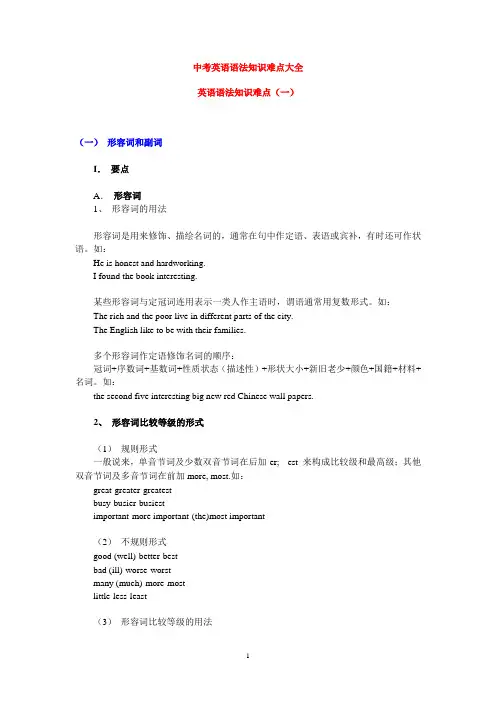
中考英语语法知识难点大全英语语法知识难点(一)(一)形容词和副词I.要点A.形容词1、形容词的用法形容词是用来修饰、描绘名词的,通常在句中作定语、表语或宾补,有时还可作状语。
如:He is honest and hardworking.I found the book interesting.某些形容词与定冠词连用表示一类人作主语时,谓语通常用复数形式。
如:The rich and the poor live in different parts of the city.The English like to be with their families.多个形容词作定语修饰名词的顺序:冠词+序数词+基数词+性质状态(描述性)+形状大小+新旧老少+颜色+国籍+材料+名词。
如:the second five interesting big new red Chinese wall papers.2、形容词比较等级的形式(1)规则形式一般说来,单音节词及少数双音节词在后加-er; --est 来构成比较级和最高级;其他双音节词及多音节词在前加more, most.如:great-greater-greatestbusy-busier-busiestimportant-more important-(the)most important(2)不规则形式good (well)-better-bestbad (ill)-worse-worstmany (much)-more-mostlittle-less-least(3)形容词比较等级的用法①表示两者的比较,用形容词的比较级+than. 如:He is cleverer than the other boys.This one is more beautiful than that one.②表示两者以上的比较,用"the +形容词最高级(+名词)+of(in) …"如:He is the cleverest boy in his class.③表示两者是同等程度,用"as +形容词原级+as". 如:He is as tall as I.I have as many books as you.④越… 越…例如:The more I learn, the happier I am.⑤You can never be too careful. 越小心越好又如:You can never praise the teacher too highly.你怎么赞扬这个老师也不过分。
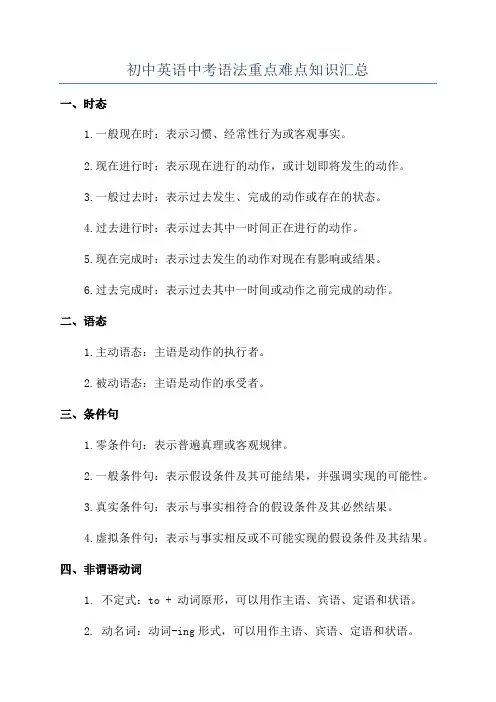
初中英语中考语法重点难点知识汇总一、时态1.一般现在时:表示习惯、经常性行为或客观事实。
2.现在进行时:表示现在进行的动作,或计划即将发生的动作。
3.一般过去时:表示过去发生、完成的动作或存在的状态。
4.过去进行时:表示过去其中一时间正在进行的动作。
5.现在完成时:表示过去发生的动作对现在有影响或结果。
6.过去完成时:表示过去其中一时间或动作之前完成的动作。
二、语态1.主动语态:主语是动作的执行者。
2.被动语态:主语是动作的承受者。
三、条件句1.零条件句:表示普遍真理或客观规律。
2.一般条件句:表示假设条件及其可能结果,并强调实现的可能性。
3.真实条件句:表示与事实相符合的假设条件及其必然结果。
4.虚拟条件句:表示与事实相反或不可能实现的假设条件及其结果。
四、非谓语动词1. 不定式:to + 动词原形,可以用作主语、宾语、定语和状语。
2. 动名词:动词-ing形式,可以用作主语、宾语、定语和状语。
3. 现在分词:动词-ing形式,可作定语、表语等。
4. 过去分词:-ed或不规则变化形式,常用作被动语态和完成时。
五、情态动词1. can/could:表示能力、许可、可能等。
2. may/might:表示允许、请求、可能、推测等。
3. must:表示推测、肯定、必需等。
4. should:表示义务、建议、推测、必要等。
六、名词1.可数名词与不可数名词及其用法。
2.名词所有格的表示方法。
七、代词1.人称代词:主格、宾格、物主代词、反身代词等。
2. 指示代词:this, that, these, those等。
3. 不定代词:some, any, no, every, all, both等。
八、形容词与副词1.形容词的比较级和最高级形式及其用法。
2.副词的比较级和最高级形式及其用法。
九、连词1. 并列连词:and, or, but等。
2. 从属连词:because, when, if, although等。

可编辑修改精选全文完整版一、初中英语语法归纳本文归纳了词法、八种基本时态以及三大基本从句,是历年中考英语必考语法点。
(一)词法1. 名词(1)名词的可数与不可数可数名词指表示的人或事物可以用数来计量,它有单数与复数两种形式。
不可数名词指所表示的事物不能用数来计量。
物质名词与抽象名词一般无法用数目,来统计,都成为不可数名词。
不可数名词前一般不能用冠词a、an来表示数量,没有复数形式。
要表示“一个……”这一概念,就须加a piece of这一类短语。
要注意许多名词在汉语里看来是可数名词,在英语里却不可数。
如:chalk,paper,bread,rice,grass,news等。
(2)名词复数的规则变化A.一般情况下加-s。
B.以s, x, ch, sh, 结尾的加-esC.以辅音字母加y结尾的改y为i再加-esD.以f,fe结尾的,去掉f或fe,变成v再加-es(3)名词的所有格A. 单数名词词尾加’s,复数名词词尾若没有s,也要加’s。
如:the worker's bike,the Children’ s ballB. 表示几个人共有一样东西,只需在最后一个人的名字后加’ s若表示各自所有,则需在各个名字后’ s。
如:This is Lucy and Licy’ s room.These are Kate's and jack’ s rooms.C. 如果是通过在词尾加—s构成的复数形式的名词,只加’。
如:the students’ books,the girls’ blouses(另外:名词+of+名词名词是有生命的,我们就用’s结构来表示所有关系。
如果名词所表示的事物是无生命的,我们就要用名词+of+名词的结构来表示所有关系。
) 2. 代词人称代词,物主代词,反身代词,指示代词,不定代词(1)人称代词第一人称单数I me my mine myself复数 we us our ours ourselves第二人称单数 you you your yours yourself复数 you you your yours yourselves第三人称单数 he him his his himselfshe her her hers herselfit it its its itself复数 they them their theirs themselves(2)物主代词物主代词的用法:形容词性物主代词后面一定要跟上一个名词;名词性物主代词可作主语、表语、宾语。

初中英语语法学习的重点和难点是什么?初中英语语法学习是学生打好英语基础的最重要的阶段,掌握好语法知识能够帮助学生更好地表达和运用英语,为未来学习更高级的英语知识打下坚实的基础。
而现在,初中英语语法也存在一些学习上的重点和难点,需要教师和学生共同努力。
一、重点1. 时态:时态是初中英语语法学习的重中之重,也是学生最熟悉的语法内容之一。
学生需要掌握各种时态的构成和用法,包括一般现在时、一般过去时、一般将来时、现在进行时、过去进行时等。
同时,也要理解和掌握一些特殊时态的用法,例如过去完成时、将来完成时等。
2. 语态:语态主要包括主动语态和被动语态,初中阶段学生必须掌握被动语态的构成和用法,并在不同语境中灵活运用。
被动语态的学习也能帮助学生更好地理解句子结构和语义,并增加英语表达的准确性和多样性。
3. 句子成分:初中英语语法学习的另一个重点是句子成分,包括主语、谓语、宾语、表语、定语、状语等。
学生需要了解每个句子成分的语法功能和构成方法,并掌握如何分析句子结构。
明白句子成分能够帮助学生清楚理解句子意思,并提高英语写作能力。
4. 冠词:冠词的使用是英语语法中一个重要的方面,也是学生容易出错的地方。
学生必须掌握定冠词、不定冠词和零冠词的用法,并在不同语境中灵活运用。
5. 代词:代词的学习是学生理解和应用英语语法的基础。
学生需要掌握人称代词、物主代词、指示代词等不同类型的代词的用法,并注意代词在句子中的指代关系。
二、难点1. 时态的复杂变化:英语时态的用法相对复杂,尤其是某些时态的构成、用法和特殊情况,例如完成时、将来时等。
学生需要理解各种时态的细微区别,并能够在不同的语境中灵活运用。
2. 语态的变换:被动语态的运用需要学生掌握其构成方法和用法,并能够根据不同的语境判断是否需要使用被动语态。
一些语法点,例如省略句、倒装句等,也需要学生对语态有深刻的理解。
3. 虚拟语气的难点:虚拟语气是初中英语语法的难点之一,学生需要理解其概念和用法,并掌握常见的虚拟语气句型和语法规则。
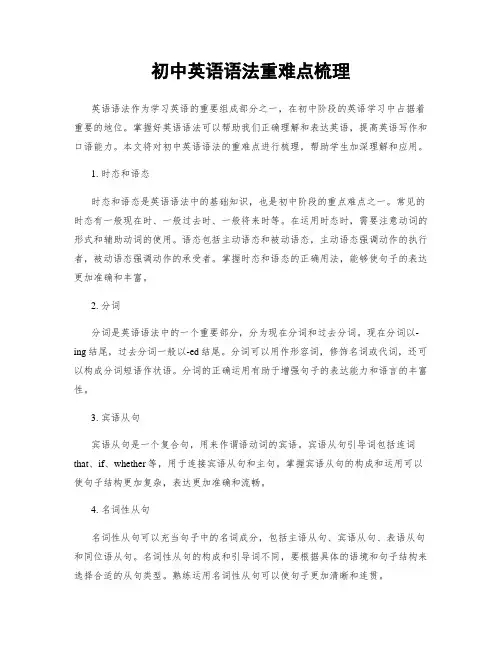
初中英语语法重难点梳理英语语法作为学习英语的重要组成部分之一,在初中阶段的英语学习中占据着重要的地位。
掌握好英语语法可以帮助我们正确理解和表达英语,提高英语写作和口语能力。
本文将对初中英语语法的重难点进行梳理,帮助学生加深理解和应用。
1. 时态和语态时态和语态是英语语法中的基础知识,也是初中阶段的重点难点之一。
常见的时态有一般现在时、一般过去时、一般将来时等。
在运用时态时,需要注意动词的形式和辅助动词的使用。
语态包括主动语态和被动语态,主动语态强调动作的执行者,被动语态强调动作的承受者。
掌握时态和语态的正确用法,能够使句子的表达更加准确和丰富。
2. 分词分词是英语语法中的一个重要部分,分为现在分词和过去分词。
现在分词以-ing结尾,过去分词一般以-ed结尾。
分词可以用作形容词,修饰名词或代词,还可以构成分词短语作状语。
分词的正确运用有助于增强句子的表达能力和语言的丰富性。
3. 宾语从句宾语从句是一个复合句,用来作谓语动词的宾语。
宾语从句引导词包括连词that、if、whether等,用于连接宾语从句和主句。
掌握宾语从句的构成和运用可以使句子结构更加复杂,表达更加准确和流畅。
4. 名词性从句名词性从句可以充当句子中的名词成分,包括主语从句、宾语从句、表语从句和同位语从句。
名词性从句的构成和引导词不同,要根据具体的语境和句子结构来选择合适的从句类型。
熟练运用名词性从句可以使句子更加清晰和连贯。
5. 比较级和最高级比较级和最高级是表示程度、大小和数量的形式之一。
比较级用于两个人或事物之间的比较,最高级表示三个或三个以上人或事物之间的比较。
比较级的构成和比较级形容词的变化规则需要掌握,同时要注意比较级的用法,包括比较级与连词than的搭配以及比较级的句式结构。
6. 介词短语介词短语通常由介词和跟在后面的名词、代词构成,用来修饰其他的词或短语。
介词短语在句子中可以表示位置、时间、方式、原因等。
熟练掌握常用的介词和介词短语的用法,能够帮助我们准确表达自己的意思。

初中语法重点与难点解析语法作为学习语言的基础,对于初中学生来说是一个重要而且相对较难的知识点。
本文将从初中语法的重点和难点两个方面进行解析,帮助学生更好地掌握语法知识。
一、初中语法重点解析1. 时态和语态时态和语态是初中语法中的重点知识,掌握好时态和语态的用法对于语言表达的准确性很重要。
在时态方面,主要包括一般现在时、一般过去时、一般将来时等。
在语态方面,主要包括主动语态和被动语态。
学生需要掌握各个时态和语态的构成规则和使用方法,并能够正确运用于句子中。
2. 名词名词作为句子中的主要成分之一,是初中语法的重要内容。
在名词的学习中,需要注意名词的单数和复数形式、所有格的形式以及可数和不可数名词的区分等。
还需要了解常见名词的分类和用法,如人名、地名、物名等。
3. 代词代词的使用在句子中起到了替代名词的作用,常见的代词有人称代词、指示代词、疑问代词和不定代词等。
学生需要学会根据语境选择适当的代词,并注意代词在句子中的位置和形式的变化。
4. 形容词和副词形容词和副词是用来修饰名词或者动词的重要词性,在初中语法中具有重要地位。
学生需要了解形容词和副词的基本用法和常见形式变化,同时学会运用形容词和副词来描述事物的特征和状态。
5. 动词动词是句子中的谓语成分,用来表示人或事物的动作、状态或存在。
在学习动词时,学生需要了解动词的时态和语态的使用,正确使用动词的不同形式和常见的动词短语。
二、初中语法难点解析1. 动词时态和语态的混用动词时态和语态的混用是初中语法中的一个常见难点。
学生常常容易混淆时态的用法,例如在叙述过去的事情时错误地使用了一般现在时。
在应对这个难点时,学生需要加强对时态和语态的理解和掌握,多做相关练习来熟悉正确的用法。
2. 非谓语动词的应用非谓语动词包括不定式、动名词和分词,学生在使用非谓语动词时常常出现用词不准确或者搭配错误的情况。
对于这个难点,学生可以通过积累常用的非谓语动词搭配和多做相关的语法练习来提高使用非谓语动词的准确性。

初中语法重难点详解知识点汇总语法是语言的基础,掌握好语法知识对于学习语言、提高语言表达能力非常重要。
在初中阶段,学生们逐渐接触到更多复杂的语法规则和结构,因此,理解和掌握初中语法的重难点是提高语文能力的关键之一。
本文将对初中语法的重难点进行详细的解析和知识点的汇总,帮助同学们更好地掌握和运用语法规则。
一、名词的数与格名词是表示人、事物、动物、地点等具体或抽象事物的词语。
名词的数与格是初中语法中的重要知识点之一。
1. 名词的单数和复数形式名词的单数形式表示一个人或一件事物,而复数形式表示多个人或多件事物。
英语名词的复数形式有很多变化规则,例如:- 大部分名词加s:books, cats.- 以s, sh, ch, x结尾的名词加es:boxes, buses.- 以y结尾的名词变y为i再加es:berries, cities.- 特殊名词变化:man - men, woman - women, child - children.2. 名词的所有格名词的所有格表示名词所属关系。
一般地,当名词是单数形式时,在名词后面加's表示所有格;当名词是复数形式时,在名词后加'。
例如:- 单数名词:the boy's book(男孩的书)- 复数名词:the boys' books(男孩们的书)二、动词的时态和语态动词是表示动作、状态或存在的词语。
动词的时态和语态是初中语法中较为复杂的部分。
1. 动词的时态动词的时态表示动作发生的时间。
英语中常见的时态有一般现在时、一般过去时、一般将来时等。
不同的时态需要根据动词的规则进行相应的变化。
例如:- 一般现在时:He goes to school every day.(他每天去学校。
)- 一般过去时:They played football yesterday.(他们昨天踢足球。
)- 一般将来时:I will visit my grandparents next week.(我下周会去看望我的祖父母。
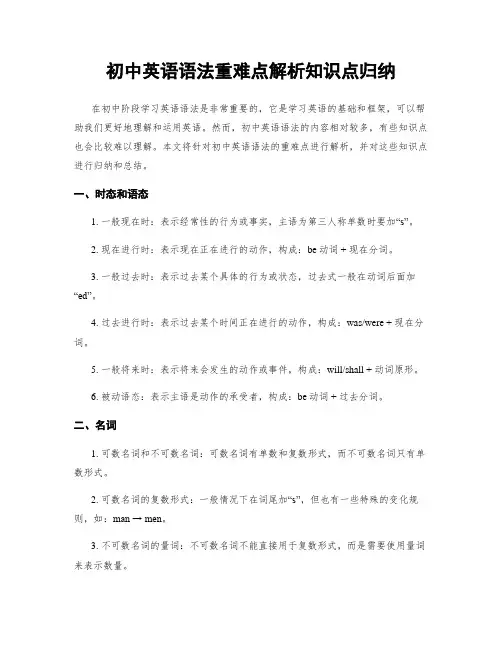
初中英语语法重难点解析知识点归纳在初中阶段学习英语语法是非常重要的,它是学习英语的基础和框架,可以帮助我们更好地理解和运用英语。
然而,初中英语语法的内容相对较多,有些知识点也会比较难以理解。
本文将针对初中英语语法的重难点进行解析,并对这些知识点进行归纳和总结。
一、时态和语态1. 一般现在时:表示经常性的行为或事实,主语为第三人称单数时要加“s”。
2. 现在进行时:表示现在正在进行的动作,构成:be动词 + 现在分词。
3. 一般过去时:表示过去某个具体的行为或状态,过去式一般在动词后面加“ed”。
4. 过去进行时:表示过去某个时间正在进行的动作,构成:was/were + 现在分词。
5. 一般将来时:表示将来会发生的动作或事件,构成:will/shall + 动词原形。
6. 被动语态:表示主语是动作的承受者,构成:be动词 + 过去分词。
二、名词1. 可数名词和不可数名词:可数名词有单数和复数形式,而不可数名词只有单数形式。
2. 可数名词的复数形式:一般情况下在词尾加“s”,但也有一些特殊的变化规则,如:man → men。
3. 不可数名词的量词:不可数名词不能直接用于复数形式,而是需要使用量词来表示数量。
三、形容词和副词1. 形容词的比较级和最高级:一般情况下在形容词后面加“-er”或“-est”,但也有一些特殊的变化规则,如:good → better → best。
2. 副词的比较级和最高级:一般情况下在副词前面加“more”或“most”,但也有一些特殊的变化规则,如:well → better → best。
四、代词1. 人称代词:主格和宾格区别,如:I(主格)→ me(宾格)。
2. 物主代词:如:my(我的), your(你的), his(他的), her(她的), its(它的), our(我们的), their(他们的)。
3. 反身代词:表示动词的行为反过来作用于自身,如:myself, yourself, himself, herself, itself, ourselves, yourselves, themselves。
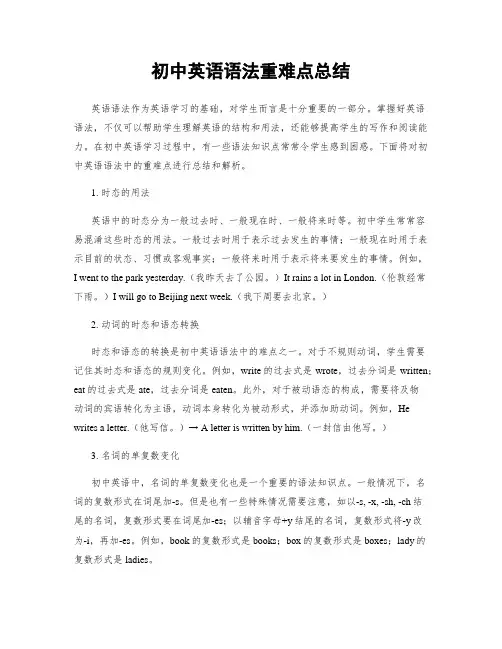
初中英语语法重难点总结英语语法作为英语学习的基础,对学生而言是十分重要的一部分。
掌握好英语语法,不仅可以帮助学生理解英语的结构和用法,还能够提高学生的写作和阅读能力。
在初中英语学习过程中,有一些语法知识点常常令学生感到困惑。
下面将对初中英语语法中的重难点进行总结和解析。
1. 时态的用法英语中的时态分为一般过去时、一般现在时、一般将来时等。
初中学生常常容易混淆这些时态的用法。
一般过去时用于表示过去发生的事情;一般现在时用于表示目前的状态、习惯或客观事实;一般将来时用于表示将来要发生的事情。
例如,I went to the park yesterday.(我昨天去了公园。
)It rains a lot in London.(伦敦经常下雨。
)I will go to Beijing next week.(我下周要去北京。
)2. 动词的时态和语态转换时态和语态的转换是初中英语语法中的难点之一。
对于不规则动词,学生需要记住其时态和语态的规则变化。
例如,write的过去式是wrote,过去分词是written;eat的过去式是ate,过去分词是eaten。
此外,对于被动语态的构成,需要将及物动词的宾语转化为主语,动词本身转化为被动形式,并添加助动词。
例如,He writes a letter.(他写信。
)→ A letter is written by him.(一封信由他写。
)3. 名词的单复数变化初中英语中,名词的单复数变化也是一个重要的语法知识点。
一般情况下,名词的复数形式在词尾加-s。
但是也有一些特殊情况需要注意,如以-s, -x, -sh, -ch结尾的名词,复数形式要在词尾加-es;以辅音字母+y结尾的名词,复数形式将-y改为-i,再加-es。
例如,book的复数形式是books;box的复数形式是boxes;lady的复数形式是ladies。
4. 形容词和副词的比较级和最高级形容词和副词的比较级和最高级也是初中英语语法中的难点之一。

中考语法重难点总结语法是英语学习中的重要组成部分,对于中考来说,掌握语法的重点和难点是考试中获取高分的关键。
本文将对中考语法的重难点进行总结,帮助学生们在备考中有针对性地进行复习。
一、时态1. 一般现在时:表示经常性、习惯性的动作或状态。
例句:I usually go to school by bus.2. 一般过去时:表示过去某个时间所发生的动作或存在的状态。
例句:He studied English last night.3. 现在进行时:表示现阶段正在进行的动作。
例句:They are playing football in the park.4. 一般将来时:表示将来要发生的动作或存在的状态。
例句:I will visit my grandparents next week.5. 现在完成时:表示动作发生在过去并和现在有关。
例句:She has lived in this city for five years.二、名词1. 可数名词和不可数名词的区分及用法。
可数名词可用于单数和复数,可与数字连用;不可数名词不能与数字连用。
例句:I have three books. (可数名词)例句:I need some water. (不可数名词)2. 单数名词的复数形式及规则。
大多数单数名词加-s,以s、x、ch、sh结尾的加-es,以辅音字母+y结尾的变y为i加-es。
例句:I saw two dogs. (dog的复数形式)三、动词1. 动词的时态和语态。
动词的时态包括一般现在时、一般过去时、现在进行时、一般将来时、现在完成时等;语态包括主动语态和被动语态。
例句:They are watching a movie now. (现在进行时)例句:The book was written by him. (被动语态)2. 动词的非谓语形式:动词不定式、动名词和现在分词。
动词不定式以to开头,动名词以-ing结尾,现在分词以-ing结尾。
初中英语语法重点与易错知识点总结英语语法是学习英语的基础,正确运用语法规则可以帮助我们更准确地表达意思,避免语法错误。
在初中英语学习中,有一些语法重点和易错知识点需要我们特别关注和掌握。
本文将从词类、时态、句型和从句等角度对初中英语语法进行总结。
一、词类1. 名词:名词是指表示人、事物、地点或概念等的词语。
英语名词具有可数和不可数两种形式,要注意可数名词的单复数形式和不可数名词的用法。
2. 代词:代词用来代替名词,在句子中起到指代作用。
常见的代词有人称代词、物主代词、反身代词和指示代词等,需要注意它们的不同形式和用法。
3. 动词:动词是表示动作、状态或存在的词语。
需要掌握动词的时态、语态和不同动词之间的搭配关系。
4. 形容词和副词:形容词用来修饰名词,副词用来修饰动词、形容词或其他副词。
要注意形容词和副词的比较级和最高级形式的变化规则。
5. 冠词:冠词用来限定名词的范围,包括定冠词和不定冠词。
需要注意冠词的用法和特殊情况。
二、时态英语中常用的时态有一般现在时、一般过去时、一般将来时等。
掌握时态的正确使用是写作和口语表达的关键。
需要注意的一些易错点如下:1. 一般现在时:表示经常性或普遍性的动作或状态。
注意第三人称单数形式的变化规则。
2. 一般过去时:表示过去发生的动作或状态。
注意动词的规则变化和不规则动词的变化。
3. 一般将来时:表示将来要发生的动作或状态。
可以使用助动词“will”或“be going to”。
三、句型1. 祈使句:祈使句用来表达请求、命令、建议或警告等,常以动词原形开头。
要注意句子的语气和使用方式,如使用“Don't”表示否定。
2. 疑问句:疑问句用来询问信息或确认事实。
需要掌握不同类型的疑问句句式和语序,如一般疑问句、特殊疑问句和选择疑问句。
3. 定语从句:定语从句用来修饰和限定名词,通常由关系代词或关系副词引导。
需要注意关系词的选择和从句的位置。
四、从句从句是句子的一个组成部分,由一个主句和一个从句构成。
初中英语语法重难点总结英语语法是学习英语的基础,它涉及到单词的词性、句子的成分、词序和语态等方面的知识。
初中阶段,学生需要掌握和运用一些重要的英语语法知识,这对于他们的日常交流和写作非常重要。
本文将总结初中英语语法的一些重难点,包括词性、时态、被动语态、虚拟语气和定语从句等。
首先,了解词性的差异对理解句子的结构起着重要的作用。
英语中常见的词性有名词、动词、形容词、副词、代词、介词等。
名词可以表示人、物、地点、抽象概念等,它不仅可以作为主语、宾语、表语等,还可以通过加's形成所有格。
动词是句子的谓语,根据语态的不同可以分为主动语态和被动语态。
形容词用来修饰名词或代词,副词一般用来修饰动词、形容词、副词或整个句子。
代词可以代替名词,分为人称代词、物主代词、指示代词、疑问代词和不定代词。
介词用来表示时间、地点、原因、方式等关系。
其次,掌握时态的用法是学好英语的关键。
英语中常见的时态有一般现在时、一般过去时、一般将来时、现在进行时、过去进行时、现在完成时和过去完成时等。
一般现在时用来表示经常性或普遍性的动作或状态。
一般过去时用来表示过去某个时间发生的动作或状态。
一般将来时用来表示将来发生的动作或状态。
现在进行时用来表示现在正在进行的动作。
过去进行时用来表示过去某个时间正在进行的动作。
现在完成时用来表示过去发生的动作对现在造成的影响。
过去完成时用来表示过去某个时间前已经发生的动作。
此外,了解被动语态的构成和用法,能够帮助我们更好地理解和运用英语。
被动语态由助动词"be"的不同时态形式加上过去分词构成,用来强调动作的承受者或者不知道动作的执行者。
被动语态的时态包括一般现在时、一般过去时、一般将来时、现在进行时、过去进行时、现在完成时和过去完成时等。
被动语态在语法结构上与主动语态相比更加复杂,需要学生通过不断的练习和积累来掌握。
虚拟语气是英语语法中的一项难点,它要求学生在条件句和主语从句中运用正确的语气。
初中英语知识点重难点总结一、词汇与语法1. 词汇积累- 重点:扩大词汇量是英语学习的基础。
学生需要通过阅读、记忆和使用新词汇来提高英语水平。
- 难点:容易忘记生词,词义辨析困难。
- 解决策略:通过制作词汇卡片、定期复习和在语境中使用新词汇来加深记忆。
2. 时态- 重点:掌握各种时态的用法,如一般现在时、一般过去时、现在进行时等。
- 难点:时态的混淆和不正确使用。
- 解决策略:通过例句和练习区分不同时态,并在写作和口语中准确运用。
3. 语态- 重点:理解主动语态和被动语态的转换。
- 难点:何时使用被动语态。
- 解决策略:学习被动语态的构成和在不同情境下的应用。
4. 非谓语动词- 重点:掌握动名词、分词和不定式的用法。
- 难点:非谓语动词的逻辑主语和时态问题。
- 解决策略:通过分析句子结构和上下文来确定非谓语动词的正确形式。
5. 句子结构- 重点:理解和构建简单句、并列句和复合句。
- 难点:复合句中从句的引导词选择和使用。
- 解决策略:通过图示和实例学习不同从句的用法,并进行针对性练习。
二、阅读理解1. 阅读技巧- 重点:提高阅读速度和理解能力。
- 难点:生词多、长句理解困难。
- 解决策略:学习略读(skimming)和扫读(scanning)技巧,通过上下文推测词义。
2. 信息获取- 重点:准确获取文章主旨和细节信息。
- 难点:区分事实信息和作者观点。
- 解决策略:练习从文章中提取关键信息,并学会区分不同类型的信息。
3. 推理判断- 重点:培养逻辑推理和判断能力。
- 难点:根据文章内容进行合理推断。
- 解决策略:通过练习题目提高推理能力,学习如何根据线索进行推断。
三、写作技巧1. 文章结构- 重点:掌握英语写作的基本结构,包括引言、正文和结尾。
- 难点:组织文章和过渡自然。
- 解决策略:学习使用连接词和过渡句,练习写作提纲的编写。
2. 表达清晰- 重点:确保写作内容清晰、准确。
- 难点:避免语法错误和不清晰的表达。
初中英语语法学习有哪些重点和难点?初中英语语法:那些年,我们一起追过的“时态”说起初中英语语法,啊,满满的回忆啊!还记得当年我初中的时候,英语老师最爱问我们:“你们觉得哪部分语法最难啊?” 然后全班同学就开始七嘴八舌,什么动词、名词、形容词,还有各种时态,简直是五花八门。
其实,说实话,初中英语语法,最难的还是那些“时态”!为什么这么说呢?因为这些时态,简直就是英语老师的“心头好”,考试必考!每种时态都有各种变态的用法,各种微妙的时态变化,简直让人头疼!就拿“现在完成时”来说吧,它可是初中英语语法的大Boss!还记得当年我教过的一个学生,叫小明,他就是被“现在完成时”折磨得死去活来。
记得有一次,我问他:你现在学英语多久了?他想了半天,很认真地说:“I study English for three years”。
我当时简直是惊呆了!这可是“现在完成时”的典型错误!应该用“I have studied English for three years”啊!我当时就觉得,怎么就那么难呢?明明看起来很简单,但就是记不住。
你看,这句话,用“for”和“since”都可以,但分别适用于不同的时间范围,然后各种搭配,简直绕死人!但是,别怕!只要你掌握了正确的学习方法,“现在完成时” 也不过如此。
比如,我们可以把“现在完成时”想象成一个“时间长河”。
我们现在所处的点,就是“现在”,而“现在完成时”就是用来描述从过去某个时间点到现在,这个时间段内的动作或状态。
我们还可以把“现在完成时”与其他时态比较,这样就能更清楚地理解它们的用法。
比如,与过去式相比,“现在完成时”所描述的动作或状态,对现在的影响更大。
当年,我也用各种方法教小明,最后他终于明白了“现在完成时”的奥秘!他告诉我,他终于可以自信地说:“I have been studying English for three years!”你看,只要找到合适的学习方法,再难的语法也能搞定!初中英语语法,虽然看起来有些挑战,但只要我们掌握了正确的学习方法,并持之以恒地练习,就能轻松克服它!记住,一切皆有可能!。
初中英语语法重难点知识点归纳英语语法在初中阶段是学习英语的重要组成部分,掌握了语法知识可以帮助学生准确、流利地表达自己的思想。
然而,英语语法中存在一些重难点知识点,对于初学者来说可能会感到困惑。
在本文中,我们将对初中英语语法的一些重难点知识点进行归纳总结,以帮助学生更好地理解和掌握这些知识。
一、时态与语态1. 一般现在时:表达经常发生的动作、习惯或真理。
如:I play basketball every Sunday.2. 现在进行时:表达当前正在进行的动作。
如:She is reading a book.3. 一般过去时:表达过去某个时间发生的动作或状态。
如:They visited Beijing last summer.4. 过去进行时:表达过去某一特定时刻正在进行的动作。
如:I was watching TV when she called.5. 现在完成时:表达过去某个时间开始,一直延续到现在的动作或状态。
如:I have lived here for 10 years.6. 过去完成时:表示过去某个时间点之前已经完成的动作。
如:She had finished her homework before her parents came back.7. 将来进行时:表示将来某个时间正在进行的动作。
如:I will be studying at this time tomorrow.8. 将来完成时:表示将来某个时间之前已经完成的动作。
如:By next month, I will have graduated from high school.9. 被动语态:将动作的承受者放在了句子的主语位置。
如:The book was written by him.二、虚拟语气1. 虚拟条件句:用于表达与事实相反的假设情况。
如:If I were you, I would study harder.2. 祝愿句:用于表达对未来情况的祝愿。
初中英语语法知识点总结初中英语的重点难点有哪些?下面是小编为大家整理的关于初中英语语法知识点总结,希望对您有所帮助。
欢迎大家阅读参考学习!名词是表示人、事物、地方、现象及其它抽象概念名称的词。
名词分为专有名词和普通名词。
专有名词是表示具体的人、事物、地点、或机构等的专有名称。
如:Guangzhou,Mike,UNESCO 等。
专有名词一般情况下第一个字母要大写。
普通名词是表示一类人、事物或抽象概念的名称。
如:police,eggs,rice 等。
普通名词又可分为个体名词、集体名词、物质名词和抽象名词。
个体名词:表示某一类人或某一类东西中的个体。
如:monkey,panda,ruler,boy 等。
集体名词:表示一群人或一类事物的总称。
如:family,police,class,people 等。
物质名词:表示无法分为个体或不具备确定形状和大小的实物。
如:Water,air,milk 等。
抽象名词:表示抽象概念词。
如:hope,love,spirit。
英语的名词有可数名词和不可数名词两种。
一般来说,个体名词和集体名词多为可数名词,物质名词和抽象名词多为不可数名词。
名词单数变复数的规则总结1. 规则变化(1)一般在名词词尾加"-s",map—maps 地图bird—birds 鸟orange—oranges 桔子bike—bikes 自行车(2)以 s, x, ch, sh 结尾的名词加"-es" box—boxes 盒子class—classes 班级watch—watches 手表dish-dishes 盘,碟子,餐具(3)以 o 结尾的无生命的名词后面加"-s" photo—photos 相片radio—radios 收音机zoo—zoos 动物园以 o 结尾的有生命的名词后面加"-es" tomato—tomatoes 西红柿potato—potatoes 土豆hero—heroes 英雄negro—negroes 黑人(4)以辅音字母加 y 结尾的名词,变 y 为 i 加"-es " baby—babies 婴儿family—families 家庭以元音字母加 y 结尾的名词直接加"-s"boy—boys 男孩toy—toys 玩具(5)以 fe 或 f 结尾的名词,把 fe 或 f 变为 v 加”-es “knife—knives 小刀wife—wives 妻子leaf—leaves 树叶。
初中英語語法重難點總結一.as … as …結構表示像...一样,强调数量或程度。
通常中间只能用形容词或副词的原级,不能用比较级或最高级。
若第二个as之后使用独立的人称代词,一般用主格(较正式)或宾格(非正式)均可。
具體用法如下:1.若涉及数量或程度,可用“as much+不可数名词+as”和“as many+可数名词复数+as”。
如:He doesn’t pay as much tax as we do / as us. 他没我们交的税款多。
There are not as many restaurants as there were. 现在餐馆没有过去多了。
2.“as+形容词或副词原级+as...”意为“和...一样”,表示同级的比较,第一个as为副词,第二个as为连词。
(1)as...as结构用于表示不同人或物同一性质的比较,意为...和...一样The tree is as tall as the building.这棵树和那栋楼一样高。
(2)as...as结构用于表示同一个人或物不同性质的比较,意为既...又...This swimming pool is as wide as it is long.这个游泳池宽度和长度相等。
(3)as...as结构用于表示两个人或物不同性质的比较,表示程度相同或相当,意为...而...,在否定句结构是so/as...as...He cannot run so/as fast as you.他没你跑得快。
He was as handsome as his wife was beautiful.他长得很英俊,他的妻子也长得非常漂亮。
3.as...as的常见句型(1)as...as possible/sb can尽可能的……Please answer my question as soon as possible.请尽快回答我的问题。
The detective is searching the man as carefully as he can.那个侦探正在尽可能仔细地搜查那个男子的身体。
(2)as...as usual/before像以前一样……She looks as pretty as before.她看起来和以前一样漂亮Though they failed,they still worked as hard as usual.尽管他们失败了,但他们仍像以前一样努力工作。
(3)as long as只要,引导条件状语从句I will stay with you as long as there is a room free.要是你有一间空余的房子,我就住在你这里。
You may borrow this book as long as you promise to give it back 只要你答应归还,你就可以把这书借走。
二.Too … to … , so … that …和such … that …1.too…to的语法:too…to的句式结构形式为“too+形容词/副词+to+动词原形”,通常翻译成“太…而不能…”。
在通常情况下,too…to…结构中的不定式可根据其是否及物来确定它是否带宾语。
Eg: He is too shy to give a speech. 他太害羞,不敢做演讲。
It's too far to get there on time. 那个地方太远,不能准时到达。
不定式的逻辑主语:有时不定式前可以带有一个由介词for引出的逻辑主语。
Eg: It's too expensive for her to buy. 太贵了,她买不起。
The box is too heavy for the boy to carry. 这个箱子太重,这男孩提不起。
2) 不定式是否带宾语:在通常情况下,too…to…结构中的不定式可根据其是否及物来确定它是否带宾语。
Eg: He is too tired to go any further. 他太累了,不能再往前走了。
The room is too dirty to live in. 这房间太脏,不能住。
3) 不定式是否用被动语态Eg: The text is too difficult to understand. 这课文太难了,理解不了。
The text is too difficult for the students to understand. 这课文太难了,学生理解不了。
2. so....that的用法:意为“如此......以至于.....”so用来修饰形容词或副词。
eg: The bag is so heavy that I can't carry it.(这个袋子太重了,我提不动)so.....that可以和too.....to.....或者enough to do sth替换。
eg:The car is so expensive that I can't afford it.=The car is too expensive for me to buy.(这辆车太贵了,我负担不起。
)eg: He is so old that he can take care of himself.=He is old enough to take care of himself.(他年龄足够大了,可以照顾自己了。
)需要注意的是:that后面加句子,to 后面加动词原形。
3. such....that的用法:such+ a/an+形容词+名词+that…eg: This is such an interesting book that we all enjoy reading it. 这本书非常有趣,我们都喜欢看。
They are such interesting books that we all enjoy reading them. 这些书很有趣,我们都喜欢看。
He shut the window with such force that the glass broke.他关窗子用力很大,玻璃都震破了。
so....that, such.....that,s o that的辨析so 从词性上来讲是副词,后面可修饰形容词/副词;such 从词性上讲是形容词,后面可以修饰单数名词,复数名词,不可数名词;(1)so....that: 意为“如此......以至于....."; so用来修饰形容词或副词。
(2)such.....that: 意为“如此......以至于.....”such用来修饰名词。
(3)so that: 意为“为的是,以便于”,用来引导目的状语从句。
eg:She was so angry that she couldn't speak.(她太生气了,以至于说不出来话了。
)It was such a boring speech that i feel asleep.(那是一个如此无聊的演讲,以至于我都睡着了。
)I read more books so that i can catch up with my classmates.(我读更多的书,以便能赶上我的同学。
)练习题:1. It was___ difficult a question that ___ people could answer it.A. so, fewB. so, a fewC. such, fewD. such, a few【答案】根据so...that, such...that的搭配,可知第一个空应该选择So. 试题翻译成“试题太难了,以致很少人答出来”,few翻译成很少,几乎没有;a few 翻译成一些。
因此答案A2. It was___ a difficult question that___people could answer it.A. so , fewB. so, a fewC. such , fewD. such, a few【答案】根据so...that, such...that的搭配,可知第一个空应该选择Such. 试题翻译成“试题太难了,以致很少人答出来”,few翻译成很少,几乎没有;a few 翻译成一些。
因此答案C三.The more …, the more … 和more and more 句型1.The more …, the more …句型:1)“the more…,the more…”句型为“the+形容词或副词比较级,the+比较级”结构,常表示“越……,就越……”,是一个复合句,其中前面的句子是状语从句,后面的句子是主句。
Eg: The more he gets,the more he wants.他越来越贪(他得到的越多,就越想要)。
The more she learns, the more she wants to learn.她越学就越想学。
2) “the+比较级,the+比较级”句型主从句的时态常用一般现在时或一般过去时。
Eg: The higher the ground is, the thinner the air becomes.离地面越高,空气就越稀薄。
The harder he worked, the more he got.他工作越努力,得到的就越多。
3) 若主句的谓语动词用一般将来时,从句的谓语动词要用一般现在时表示将来。
The harder you work, the greater progress you will make.你越用功,进步就越大。
The longer the war lasts, the more the people there will suffer.战争持续越久,那里的人们受难就越多。
2. more and more 句型more and more表示原来越怎么样,一般是修饰多音节单词的和名词。
表示的是一种动态。
例如:more and more beautiful ,越来越美丽。
名词例如:more and more people,越来越多的人。
但是单音节表示越来越的意思就在后面直接加er,不需要more。
There are more and more books in the library.图书馆里的书越来越多了。
English is becoming more and more important.We must work hard at it.英语变得越来越重要了,我们必须努力学好它。
四.How long, how often, how soon的用法1.how long的用法1)第一種情況是一般对过去发生的时间提问,例如我们平时说的某件事花费了多长时间都可以用how long来询问。